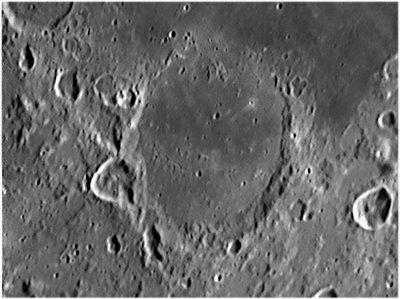 Fracastorius is the lava-flooded remnant of an ancient lunar impact crater located at the southern edge of Mare Nectaris. To the northwest of this formation lies the Beaumont crater, while to the northeast is Rosse.
Fracastorius is the lava-flooded remnant of an ancient lunar impact crater located at the southern edge of Mare Nectaris. To the northwest of this formation lies the Beaumont crater, while to the northeast is Rosse.The northern wall of this crater is missing, with only mounds appearing in the lunar mare to mark the outline. The lava that formed Mare Nectaris also invaded this crater, so the structure now forms a bay-like extension. The remainder of the rim is heavily worn and covered in lesser impact craters, leaving little of the original rim intact. The maximum elevation of the rim is 2.4 km. The most prominent of these craters is 'Fractastorius D', which overlays a portion of the western rim.
The Fracastorius crater has no central peak, but a long, slender rille runs across the middle of the floor in a generally east-west direction.
 Aristoteles is a lunar impact crater that lies near the southern edge of the Mare Frigoris, and to the east of the Montes Alpes mountain range. To the south of Aristoteles lies the slightly smaller crater Eudoxus, and these two form a distinctive pair for a telescope observer. An arc of mountains between these craters bends to the west, before joining the walls. The smaller Mitchell crater is directly attached to the eastern rim of Aristoteles. To the west is the low, flooded Egede crater.
Aristoteles is a lunar impact crater that lies near the southern edge of the Mare Frigoris, and to the east of the Montes Alpes mountain range. To the south of Aristoteles lies the slightly smaller crater Eudoxus, and these two form a distinctive pair for a telescope observer. An arc of mountains between these craters bends to the west, before joining the walls. The smaller Mitchell crater is directly attached to the eastern rim of Aristoteles. To the west is the low, flooded Egede crater.Observers have noted the crater wall of Aristoteles is slightly distorted into a rounded hexagon shape. The inner walls are wide and finely terraced. The outer ramparts display a generally radial structure of hillocks through the extensive blanket of ejecta. The crater floor is uneven, and covered in hilly ripples. Aristoteles does possess central peaks, but they are somewhat offset to the south. wikipedia
3 image mosaic, using 2.5x Powermate and IR pass filter.

